Kickboxing
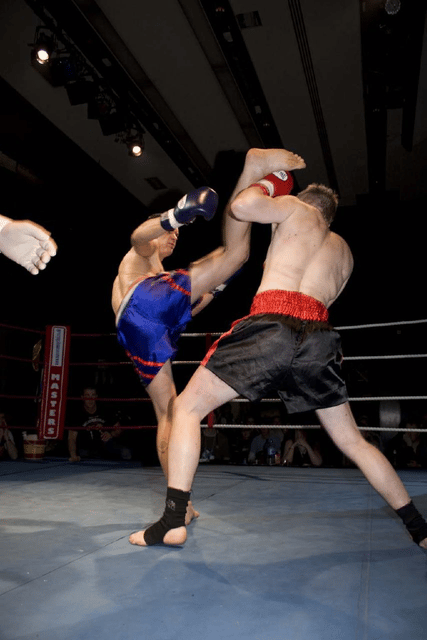
Kickboxing

| Focus | Kicking,striking |
|---|---|
| Hardness | Full-contact |
| Country of origin | Japan |
| Creator | Osamu Noguchi[1]Tatsuo Yamada |
| Famous practitioners | seelist of kickboxers |
| Parenthood | Karate,Muay Thai,Boxing,Taekwondo |
| Descendant arts | Shoot boxing |
| First played | Japan, late 1950s |
| Characteristics | |
| Contact | Yes |
| Mixed gender | No |
| Type | Combat sport |
| Presence | |
| Country or region | Worldwide |
| Olympic | No |
| World Games | 2017(invitational) |
Japanese kickboxing originated in the late 1950s, with competitions held since then.[8][9][10][11] American kickboxing originated in the 1970s and was brought to prominence in September 1974, when the Professional Karate Association (PKA) held the first World Championships. Historically, kickboxing can be considered a hybrid martial art formed from the combination of elements of various traditional styles. This approach became increasingly popular since the 1970s, and since the 1990s, kickboxing has contributed to the emergence of mixed martial arts via further hybridization with ground fighting techniques from Brazilian jiu-jitsu and folk wrestling.
There is no single international governing body.
International governing bodies include International Combat Organisation, World Association of Kickboxing Organizations, World Kickboxing Association, International Sport Karate Association, International Kickboxing Federation, World Kickboxing Network, among others. Consequently, there is no single kickboxing world championship, and champion titles are issued by individual promotions, such as K-1, Glory and Kunlun Fight among others. Bouts organised under different governing bodies apply different rules, such as allowing the use of knees or clinching, etc.[12]
| Focus | Kicking,striking |
|---|---|
| Hardness | Full-contact |
| Country of origin | Japan |
| Creator | Osamu Noguchi[1]Tatsuo Yamada |
| Famous practitioners | seelist of kickboxers |
| Parenthood | Karate,Muay Thai,Boxing,Taekwondo |
| Descendant arts | Shoot boxing |
| First played | Japan, late 1950s |
| Characteristics | |
| Contact | Yes |
| Mixed gender | No |
| Type | Combat sport |
| Presence | |
| Country or region | Worldwide |
| Olympic | No |
| World Games | 2017(invitational) |
Terminology
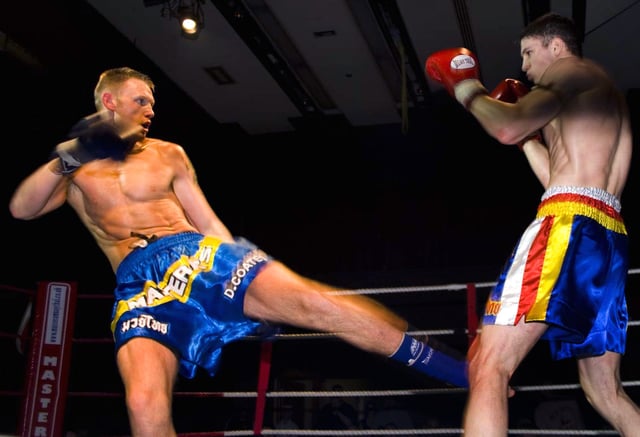
Low kick (roundhouse kick)
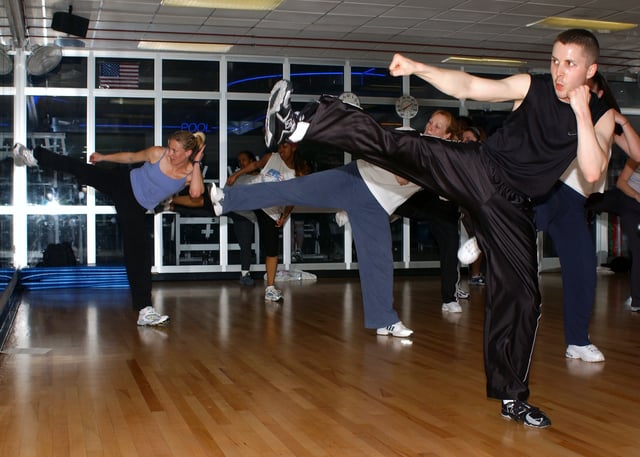
Kickboxing workout
The term "kickboxing" kickboxing (キックボクシング) can be used in a narrow and in a broad sense.
The narrow use is restricted to the styles that self-identify as kickboxing, i.e. Japanese kickboxing (with its spin-off styles or rules such as shoot boxing and K-1), Dutch kickboxing, and American kickboxing.
In the wider sense, it includes all stand-up combat sports that allow both punching and kicking, including Muay Thai, Kun Khmer, Savate, Adithada, Lethwei, Sanda, and certain styles of karate (especially full contact karate).
The term itself was introduced in the 1960s as a Japanese anglicism by Japanese boxing promoter Osamu Noguchi for a hybrid martial art combining Muay Thai and karate which he had introduced in 1958. The term was later also adopted by the American variant. Since there has been a lot of cross-fertilization between these styles, with many practitioners training or competing under the rules of more than one style, the history of the individual styles cannot be seen in isolation from one another.
The French term Boxe pieds-poings (literally "feet-fists-boxing") is also used in the sense of "kickboxing" in the general meaning, including French boxing (Savate) as well as American, Dutch and Japanese kickboxing, Burmese and Thai boxing, any style of full contact karate, etc.
Arts labeled as kickboxing in the general sense include:
The Indochinese family of kickboxing sports (also known generically as muay [13]) including: Pradal Serey – similar to Muay Thai with an emphasis on elbow techniques (Ring-wise). Also known as Kun Khmer. Thai Muay Boran (Ancient boxing) – Predecessor of Muay Thai, allows the use of headbutts. Thai kickboxing or Muay Thai – the modern Thai martial art with strong emphasis on knee and elbow strikes.[14] Burmese Lethwei, a traditional Burmese martial art of which has now grown into a popular kickboxing event with strong emphasis on knee, elbow strikes and headbutt. Any part of the body may be used to strike and be struck. It is also known as Bando kickboxing. Laotian Muay Lao – Laotian boxing which is similar to Muay Thai Filipino Yaw-Yan – Sayaw ng Kamatayan (Dance of Death) is the proper name for Yaw-Yan, a Filipino martial art developed by Napoleon Fernandez. The art resembles Muay Thai in a sense, but differs in the hip torquing motion as well as downward-cutting nature of its kicks and with strong emphasis on delivering attacks from long range.
Indian Musti yuddha (also known as Muki boxing) and Adithada, a form of kickboxing that uses knee, elbow and forehead strikes in Southern kalaripayattu.
French Savate, a historical sport which developed in the 19th century.[15] It is mostly known for its foot-kicking techniques.
Ukrainian Combat Hopak is mostly built around punching and kicking techniques.
modern competition-oriented hybrid martial arts that developed in parallel with Japanese and American kickboxing: Dutch Kickboxing — incorporate styles of Muay Thai, Boxing, and Kyokushin style of Karate. Any style of Full contact Karate Sanda (Chinese Kickboxing ) – The applicable component of wushu/kung fu of which takedowns and throws are legal in competition as well as all other sorts of striking (use of arms and legs).[16] Shoot boxing – A Japanese form of kickboxing which allows throwing and submission while standing, similar to Sanda.
History
Overview
Since kickboxing is a broad term, understanding the history can be somewhat difficult.
Some of the earliest forms of kickboxing included the various Indochinese martial arts especially muay boran, which developed into modern Muay Thai.
However, in terms of modern competition, it was during the 1950s that a Japanese karateka named Tatsuo Yamada first established an outline of a new sport that combined karate and Muay Thai.
This was further explored during the early 1960s, when competitions between karate and Muay Thai began, which allowed for rule modifications to take place.
By the middle of the decade the first true kickboxing events were being held in Osaka.
By the 1970s and 1980s, the sport had expanded beyond Japan and had reached North America and Europe.
It was during this time that many of the most prominent governing bodies were formed.
In Japan the sport was widely popular and was regularly broadcast on television before going into a dark period during the 1980s.
In North America the sport had unclear rules so kickboxing and full contact karate were essentially the same sport.
In Europe the sport found marginal success but did not thrive until the 1990s.
Since the 1990s the sport has been mostly dominated by the Japanese K-1 promotion, with some competition coming from other promotions and mostly pre-existing governing bodies.
Along with the growing popularity in competition, there has been an increased amount of participation and exposure in the mass media, fitness, and self-defense.
Japan
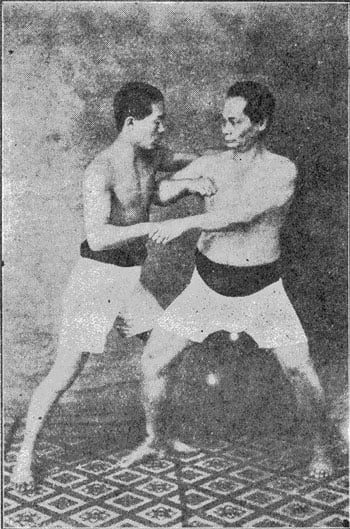
Tatsuo Yamada (left) and his master, Choki Motobu (right)
On December 20, 1959, a Muay Thai match among Thai fighters was held at Asakusa town hall in Tokyo. Tatsuo Yamada, who established "Nihon Kempo Karate-do", was interested in Muay Thai because he wanted to perform karate matches with full-contact rules since practitioners are not allowed to hit each other directly in karate matches. At this time, it was unimaginable to hit each other in karate matches in Japan. He had already announced his plan which was named "The draft principles of project of establishment of a new sport and its industrialization" in November 1959, and he proposed the tentative name of "karate-boxing" for this new sport.[17] It is still unknown whether Nak Muay were invited by Yamada, but it is clear that Yamada was the only karateka who was really interested in Muay Thai. Yamada invited a champion Nak Muay (and formerly his son Kan Yamada's sparring partner), and started studying Muay Thai. At this time, the Thai fighter was taken by Osamu Noguchi who was a promoter of boxing and was also interested in Muay Thai.[10][18] The Thai fighter's photo was on the magazine "The Primer of Nihon Kempo Karate-do, the first number" which was published by Yamada.
There were "Karate vs. Muay Thai fights" on February 12, 1963.
The three karate fighters from Oyama dojo (kyokushin later) went to the Lumpinee Boxing Stadium in Thailand and fought against three Muay Thai fighters. The three kyokushin karate fighters' names are Tadashi Nakamura, Kenji Kurosaki and Akio Fujihira (also known as Noboru Osawa). The Muay Thai team were composed of only one authentic Thai fighter.[19] Japan won by 2–1: Tadashi Nakamura and Akio Fujihira both KOed opponents by punch while Kenji Kurosaki, who fought the Thai, was KOed by elbow. The only Japanese loser Kenji Kurosaki was then a kyokushin instructor rather than a contender and temporarily designated as a substitute for the absent chosen fighter. On June of the same year, karateka and future kickboxer Tadashi Sawamura faced against top Thai fighter Samarn Sor Adisorn, in which Sawamura was knocked down 16 times and defeated.[19] Sawamura would use what he learned in that fight to incorporate in the evolving kickboxing tournaments.
Noguchi studied Muay Thai and developed a combined martial art which Noguchi named kick boxing, which absorbed and adopted more rules than techniques from Muay Thai. The main techniques of kickboxing are still derived from Japanese full contact karate (kyokushin). However, throwing and butting were allowed in the beginning to distinguish it from Muay Thai. This was later repealed. The Kickboxing Association, the first kickboxing sanctioning body, was founded by Osamu Noguchi in 1966 soon after that. Then the first kickboxing event was held in Osaka on April 11, 1966.
Tatsu Yamada died in 1967, but his dojo changed its name to Suginami Gym, and kept sending kickboxers off to support kickboxing.[20]
Kickboxing boomed and became popular in Japan as it began to be broadcast on TV.[21] By 1970, kickboxing was telecast in Japan on three different channels three times weekly. The fight cards regularly included bouts between Japanese (kickboxers) and Thai (Muay Thai) boxers. Tadashi Sawamura was an especially popular early kickboxer. In 1971 the All Japan Kickboxing Association (AJKA) was established and it registered approximately 700 kickboxers. The first AJKA Commissioner was Shintaro Ishihara, the longtime Governor of Tokyo. Champions were in each weight division from fly to middle. Longtime Ilyushiner Noboru Osawa won the AJKA bantamweight title, which he held for years. Raymond Edler, an American university student studying at Sophia University in Tokyo, took up kickboxing and won the AJKC middleweight title in 1972; he was the first non-Thai to be officially ranked in the sport of Thai boxing, when in 1972 Rajadamnern ranked him no. 3 in the Middleweight division. Edler defended the All Japan title several times and abandoned it. Other popular champions were Toshio Fujiwara and Mitsuo Shima. Most notably, Fujiwara was the first non-Thai to win an official Thai boxing title, when he defeated his Thai opponent in 1978 at Rajadamnern Stadium winning the lightweight championship bout.
By 1980, due to poor ratings and then infrequent television coverage, the golden-age of kickboxing in Japan was suddenly finished.
Kickboxing had not been seen on TV until K-1 was founded in 1993.
In 1993, as Kazuyoshi Ishii (founder of Seidokaikan karate) produced K-1 under special kickboxing rules (no elbow and neck wrestling) in 1993, kickboxing became famous again.[22][23] In the mid-1980s to early 1990s, before the first k-1, Kazuyoshi Ishii also partook in the formation of glove karate as an amateur sport in Japan.
Glove karate is based on knockdown karate rules, but wearing boxing gloves and allowing punches to the head. In effect, it is oriental rules kickboxing with scoring based on knockdowns and aggression rather than the number of hits. As K-1 grew in popularity, Glove karate for a while became the fastest growing amateur sport in Japan.
North America
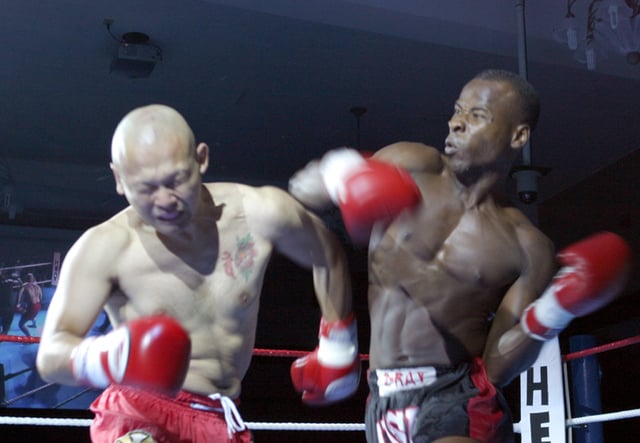
Hook-punch
Count Dante, Ray Scarica and Maung Gyi held the United States' earliest cross-style full-contact style martial arts tournaments as early as 1962. Between 1970 and 1973 a handful of kickboxing promotions were staged across the USA.
The first recognized bout of this kind occurred on January 17, 1970, and came about when Joe Lewis, a Shorin Ryu stylist who had also studied Jeet Kune Do with the legendary Bruce Lee, and noted champion in the Karate tournament circuit, grew disillusioned with the point-sparring format and sought to create an event that would allow martial artists to fight to the knock out. Enlisting the help of promoter Lee Faulkner,[24] training in boxing and combining the techniques of boxing and Karate for the first time in America, Lewis arranged the bout to be held at the 1st Pro Team Karate Championships. Lewis faced Kenpo stylist Greg "Om" Baines,[25] who had defeated two opponents in years pasts. Lewis won the fight by knockout in the second round. The event was advertised as "Full contact" but the announcers referred to it as Kickboxing, and rules included knees, elbows and sweeps.[25] Lewis would defend his U.S Heavyweight champion title 10 times, remaining undefeated until he came back from his retirement. In the early days, the rules were never clear; one of the first tournaments had no weight divisions and all the competitors fought off until one was left. During this early time, kickboxing and full contact karate are essentially the same sport.
The institutional separation of American full-contact karate from kickboxing occurred with the formation of the Professional Karate Association (PKA) in 1974 and of the World Kickboxing Association (WKA) in 1976. They were the first organised body of martial arts on a global scale to sanction fights, create ranking systems, and institute a development programme.
The International Kickboxing Federation (IKF) and the International Sport Kickboxing Association (ISKA) have been the only organizations to have thrived in the modern era.
The International Kickboxing Federation (IKF) was founded in 1992 by Steve Fossum and Dan Stell. Stell eventually stepped down to go back to fighting while Fossum continued with the organization. In 1999 Fossum and Joe Taylor of Ringside Products created the first amateur open North American tournament for Kickboxing and Muay Thai, now the IKF World Classic.
After ending its venture with K-1 in 2006, ISKA co-operated the World Combat League with Chuck Norris, and Strikeforce MMA in partnership with Silicon Valley Entertainment (SVE), an investor group who also own the San Jose Sharks. Norris passed the WCL to his son-in-law Damien Diciolli in 2007, and it has since become inactive. Strikeforce MMA was sold to UFC in 2011.
The ISKA expanded into sport (tournament) martial arts about 15 years ago, and is a co-operator along with WAKO and Global Marketing Ventures (GMV) in the global Open World Tour (OWT) the first worldwide pro circuit of sport karate professional competitors.
It sanctions and assists in the annual US Open & ISKA World Championships that anchors the OWT and the North American-based NASKA Tour.
The US Open & ISKA World Championships is broadcast live on ESPN2 and ESPN3 each year.
Other kickboxing sanctioning bodies include World Association of Kickboxing Organizations (primarily amateurs) and KICK International.
Europe
In West Germany, American-styled kickboxing was promulgated from its inception in the 1970s by Georg F. Bruckner, who in 1976 was the co-founder of the World Association of Kickboxing Organizations. The term "kickboxing" as used in German-speaking Europe is therefore mostly synonymous with American kickboxing. The elbow and knee techniques allowed in Japanese kickboxing, by contrast, were associated with Muay Thai, and Japanese kickboxing went mostly unnoticed in German-speaking Europe before the launch of K-1 in 1993.
By contrast, in the Netherlands kickboxing was introduced in its Japanese form, by Jan Plas and Thom Harinck who founded NKBB (The Dutch Kickboxing Association) in 1976. Harinck also founded the MTBN (Dutch Muay Thai Association) in 1983, and the WMTA (World Muay Thai Association) and the EMTA (European Muay Thai Association) in 1984. The most prominent kickboxing gyms in the Netherlands, Mejiro Gym, Chakuriki Gym and Golden Glory, were all derived from or were significantly influenced by Japanese kickboxing and kyokushin karate.
Dutch athletes have been very successful in the K-1 competitions.
Out of the 19 K-1 World Grand Prix championship titles issued from 1993 to 2012, 15 went to Dutch participants (Peter Aerts, Ernesto Hoost, Remy Bonjasky, Semmy Schilt and Alistair Overeem). The remaining four titles were won by Branko Cikatić of Croatia in 1993, Andy Hug of Switzerland in 1996, Mark Hunt of New Zealand in 2001 and Mirko Filipović of Croatia in 2012.
Modern sport
Kickboxing promotions
Some of the top kickboxing promotions in the world are:
Glory
K-1
Kunlun Fight
Individual rulesets
Kickboxing has a number of different rulesets.
For example, American kickboxing and/or American full contact karate restricts to strikes using punches and higher kicks; whereas some other arts often regarded as "kickboxing" allow low kicks and even knee strikes, elbows, and grappling maneuvers. All forms of kickboxing use an identical scoring system, however. A winner is declared during the bout if there is a submission (fighter quits or fighter's corner throws in the towel), knockout (KO), or referee stoppage (technical knockout, or TKO). If all of the rounds expire with no knockout then the fight is scored by a team of 3 judges. The judges determine a winner based on their scoring of each round. A split decision indicates a disagreement between the judges, while a unanimous decision indicates that all judges saw the fight the same way and all have declared the same winner.
Full contact
Full contact rules, or American kickboxing, is essentially a mixture of Western boxing and traditional karate.[26] The male kickboxers are bare-chested wearing kickboxing trousers and protective gear including: mouth-guard, hand-wraps, 10 oz (280 g). boxing gloves, groin-guard, shin-pads, and kick-boots and protective helmet (for amateurs and those under 16). The female kickboxers will wear a sports bra and chest protection in addition to the male clothing/protective gear.[27] also although there have been many organizations the PKA was the first and adopted the above waist kick rule only to create a more appealing option for TV and mainstream Americans with the hope that using a lot of flashy movie type kicks would draw in crowds and fans which it did in ways but it was the inception of the WKA founded by Howard Hanson and Arnold Urquidez which went internationally and started allowing the use of low kicks after the Urquidez brothers were challenged by Thai fighters living in California looking to spread Muay Thai in the USA in the mid 70s which helped the most notable and internationally famous younger brother Benny "the jet" Urquidez which his early fights with Muay Thai fighters helped him learn and adapt helping him become very successful against the elite Japanese fighters.
Notable fighters under full contact rules include, Dennis Alexio, Joe Lewis, Rick Roufus, Jean-Yves Thériault, Benny Urquidez, Bill Wallace, Demetrius Havanas, Billy Jackson, Pete Cunningham, and Don "The Dragon" Wilson
Rules:
Opponents are allowed to hit each other with punches and kicks, striking above the waist.
Elbows and knees are forbidden and the use of the shins is seldom allowed.
Clinch fighting and grappling are forbidden, sweeps are legal but vary depending on the referee.
Bouts are usually 3 to 10 rounds (lasting 2–3 minutes each) with a 1-minute rest in between rounds.
Semi-Contact
Semi-contact rules or Points Fighting, is the variant of American kickboxing most similar to karate, since it consists in fighting for the purpose of scoring points with an emphasis on delivery, speed, and technique. Under such rules, fights are held on the tatami, presenting the belts to classify the fighters in order of experience and ability. The male kickboxers wear shirts and kickboxing trousers as well as protective gear including: mouth-guard, hand-wraps, 10 oz (280 g). boxing gloves, groin-guard, shin-pads, kick-boots, and headgear. The female kickboxers will wear a sports bra and chest protection in addition to the male clothing/protective gear.
Notable fighters under semi-contact rules include Raymond Daniels, Michael Page, and Gregorio Di Leo. There is also a guinness world record for semi contact also known as light continuous, the world record is for the most consecutive three minute rounds with one minute rest between the record stands at 135 and took nine hours to complete. The record used a modified rule set (known as the world record rules) from the British Kickboxing Council or BKC. The record was set in 2017 as part of a fund raiser for charity and has yet to be beaten.
Rules:
Fighters can score through punches or kicks, striking above the waist and foot sweeps, executed below the ankle.
Punches, kicks, and foot sweeps are awarded 1 point.
Kicks to the head or jumping kicks to the body are awarded 2 points.
Jumping kicks to the head are awarded 3 points.
Hook kicks and Axe kicks are allowed but must be executed with the sole of the foot.
The use of the shins is seldom allowed, save for jumping and spinning techniques.
Elbows, knees, and spinning backfists are forbidden.
Clinch fighting, throws and sweeps (with the exception of foot sweeps) are forbidden.
Bouts are usually 3 rounds (lasting 2–3 minutes each) with a 1-minute rest in between rounds.[28]
International
International rules, or freestyle rules (also known simply as Kickboxing in Europe and Low Kick in the United States), contrasts with full contact rules in that it also allows low kicks. The male kickboxers are bare-chested wearing kickboxing trousers or shorts and protective gear including: mouth-guard, hand-wraps, shin-wraps, 10 oz (280 g). boxing gloves and groin-guard. The female kickboxers will wear a sports bra and chest protection in addition to the male clothing/protective gear.
Notable fighters under international rules include Rick Roufus and Abraham Roqueñi.
Rules:
Fighters are allowed to strike their opponent with punches and kicks, including kicks below the waist, except for the groin.
Elbows and knees are forbidden.
Clinch fighting, throws and sweeps are forbidden.
Bouts are 3 to 5 rounds for amateurs and 3 to 10 rounds for professionals, all rounds lasting 2-3 minutes each.
Each round has a 1-minute rest in between rounds.
Muay Thai
Muay Thai, or Thai boxing, rules usually sees bouts contested over 5, 3 minute rounds and male fighters bare-chested wearing shorts and protective gear including: mouth-guard, hand-wraps, shin-wraps, 10 oz (280 g). boxing gloves, groin-guard and sometimes prajioud arm bands. The female Thaiboxers will wear a sports bra and chest protection in addition to the male clothing/protective gear. Muay Thai is unique in that it is the only style of kickboxing that allows elbows, knees, clinch fighting, throws, sweeps and low kicks. Groin strikes were allowed until the 1980s in international Muay Thai and are still permitted in Thailand itself (though the boxers wear cups to lessen the impact). Kicking to mid-body and head are scored highly generating a large number of points on judges' scorecards. Moreover, kicking is still judged highly even if the kick was blocked. In contrast, punching is worth fewer points.
Notable fighters under Muay Thai rules include Apidej Sit Hrun, Buakaw Por. Pramuk, Changpuek Kiatsongrit, Rob Kaman, Ramon Dekkers, Coban Lookchaomaesaitong, Dieselnoi Chor Thanasukarn, Saenchai P.K. Saenchaimuaythaigym, Samart Payakaroon and Yodsanklai Fairtex.
Rules:
Fighters are allowed to strike their opponent with punches, kicks, including kicks below the waist, elbows and knees.
Clinch fighting, throws and sweeps are allowed.
Bouts are generally 5, 3-minute rounds with 2 minutes rest in between, but 3 round fights are used.
Oriental
Oriental rules, also known as Japanese kickboxing and K-1 rules, is a combat sport created by the Japanese boxing promoter Osamu Noguchi and Karate practitioner Tatsuo Yamada. It was the first combat sport that adopted the name of "kickboxing" in 1966, later termed "Japanese kickboxing" as a retronym.[9] Oriental rules bouts were traditionally fought over 5, 3-minute rounds but 3 round bouts have since become popular since their inception in the K-1 promotion. The male kickboxers are bare-chested wearing shorts (although trousers and karate gis have been worn) and protective gear including: mouth-guard, hand-wraps, shin-wraps, 10 oz (280 g). boxing gloves and groin-guard. The female kickboxers will wear a sports bra and chest protection in addition to the male clothing/protective gear.
Notable fighters under Oriental rules include Peter Aerts, Remy Bonjasky, Toshio Fujiwara, Ernesto Hoost, Albert Kraus, Masato, Giorgio Petrosyan, Tadashi Sawamura and Semmy Schilt
Rules:
Fighters are allowed to strike their opponent with punches, kicks and knees including kicks below the waist, except for the groin.
Elbow strikes on the head are forbidden.
Limited clinch fighting is allowed.
Bouts are 3 to 5 rounds (lasting 3 minutes each) with a 1-minute rest in between rounds.
Headbutts, throws and sweeps were banned in 1966 for fighters' safety.
Sanshou
Sanshou, or Sanda, (also known as Chinese boxing) is a form of kickboxing originally developed by the Chinese military based upon the study and practices of traditional Kung fu and modern combat fighting techniques; it combines traditional kickboxing, which include close range and rapid successive punches and kicks, with wrestling, takedowns, throws, sweeps, kick catches, and in some competitions, even elbow and knee strikes. The male fighters are bare-chested wearing shorts and protective gear including: mouth-guard, hand-wraps, 10 oz (280 g) boxing gloves and groin-guard. The female kickboxers will wear a sports bra and chest protection in addition to the male clothing/protective gear.
Notable fighters under Sanshou rules include Pat Barry, Zhang Tiequan, Liu Hailong, Cung Le, Shahbulat Shamhalaev and Shamil Zavurov.
Rules:
Fighters are allowed to strike their opponent with punches and kicks including kicks below the waist, except for the groin.
Elbows and knees are forbidden (with the exception of some competitions).
Clinch fighting, throws and sweeps are allowed.
Bouts are 5 rounds (lasting 3 minutes each) with a 1-minute rest in between rounds.
Shoot boxing
Shoot boxing is a unique style of kickboxing popular in Japan that utilizes standing submissions such as chokeholds, armlocks and wristlocks in addition to kicks, punches, knees and throws. The male fighters are bare-chested wearing skin tight trousers and protective gear including: mouth-guard, hand-wraps, 10 oz (280 g). boxing gloves and groin-guard. The female kickboxers will wear a sports bra and chest protection in addition to the male clothing/protective gear.
Notable fighters under shoot boxing rules include Rena Kubota, Kenichi Ogata, Hiroki Shishido, Andy Souwer and Ai Takahashi.
Rules:
Opponents are allowed to strike each other with punches, kicks, including kicks below the waist, except for the groin, and knees.
Elbows are forbidden.
Clinch fighting, throws and sweeps are allowed.
Standing submissions are allowed.
Bouts are 3 rounds (lasting 3 minutes each) with a 1-minute rest in between rounds.
Techniques
Punching
Punching techniques are very much identical to boxing punches, including
Jab – straight punch from the front hand. The arm extends from the side of the torso which is quickly turned concurrently with this action. A jab may be directed at an opponent's head or body, and is often used in conjunction with the cross.
Cross – straight punch from the back hand
Hook – rounded punch to either the head or body in an arching motion, usually not scored in points scoring
Uppercut – rising punch striking to the chin
Short straight-punch usually striking to the chin
Backfist usually from the front hand, reverse-back fist and spinning back-fist both usually from the back hand – are strikes to the head, raising the arm and bending the arm at the elbow and then straightening the arm quickly to strike to the side of the head with the rear of the knuckles.
Flying-punch struck usually from the rear hand, the combatant hops on the front foot, kicking back with the rear foot and simultaneously extending the rear hand as a punch, in the form of "superman" flying through the sky.
Cross-counter is a counterpunch begun immediately after an opponent throws a jab, exploiting the opening in the opponent's position.
Overhand (overcut or drop) – a semi-circular and vertical punch thrown with the rear hand. It is usually when the opponent bobbing or slipping. The strategic utility of the drop relying on body weight can deliver a great deal of power.
Bolo punch – a combination of a wide uppercut/right cross/swing that was delivered seemingly from the floor
Half-hook – a combination of a wide jab/hook or cross/hook
Half-swing – a combination of a wide hook/swing
Kicking
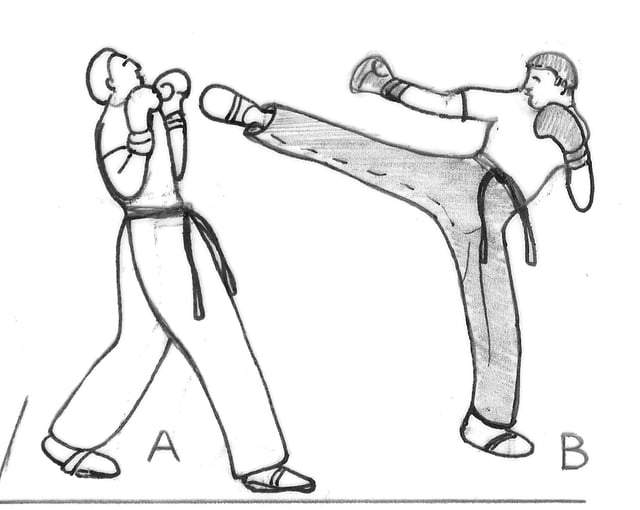
Roundhouse kick
The standard kicking techniques are:
Front kick or push Kick/high Kick – Striking face or chest on with the balls of the foot
Side kick – Striking with the heel of the foot with leg parallel to the ground, can be performed to either the head, leg or body
Semi-circular kick or forty five degree roundhouse kick
Roundhouse kick or circle kick – Striking with the front of the foot or the shin to the head or the body in a chopping motion
There are a large number of special or variant kicking techniques, including spinning kicks, jumping kicks, and other variants such as
Hook kick (heel kick) – Extending the leg out to the side of the body, and hooking the leg back to strike the head with either the heel or sole
Crescent kick and forward crescent kick
Axe kick – is a stomp out kick or axe kick. The stomp kick normally travels downward, striking with the side or base heel.
Back kick – is delivered with the base heel of the foot.
Sweeping – One foot or both feet of an opponent may be swept depending upon their position, balance and strength.
Spinning versions of the back, side, hook and axe kicks can also be performed along with jumping versions of all kicks.
Knee and elbow strikes
The knee and elbow techniques in Japanese kickboxing, indicative of its Muay Thai heritage, are the main difference that separates this style from other kickboxing rules.
See ti sok and ti khao
Straight knee (long-range knee kick or front heel kick). This knee strike is delivered with the back or reverse foot against an opponent's stomach, groin, hip or spine an opponent forward by the neck, shoulder or arm.
Flying knee – can be delivered with the front or back foot. It makes an explosive snap upwards to strike an opponent's face, chin, throat or chest.
Hook knee – can be delivered with the front or back foot. It makes a half circle spin and strikes the sides of an opponent.
Side knee – is a highly-deceptive knee technique used in close-range fighting. The knee is lifted to the toes or lifted up, and is snapped to left and right, striking an opponent's sensitive knee joints, insides of thighs, groin.
Side elbow - most commonly used elbow, commonly seen in Thai boxing fights
Upward elbow - used in the clinch to strike the opponent’s nose, chin or both
Downward elbow - used as a replacement to an overhand striking down from just under the forehead to the chin
Defense
There are three main defensive positions (guards or styles) used in kickboxing.
Within each style, there is considerable variation among fighters, as some fighters may have their guard higher for more head protection while others have their guard lower to provide better protection against body punches.
Many fighters vary their defensive style throughout a bout in order to adapt to the situation of the moment, choosing the position best suited to protect them.
Slip –Slipping
Bob and weave –bobbing
Parry/Block –Parrying orblocking
The cover-up – Covering up
The clinch –Clinching is a form of standing grappling and occurs when the distance between both fighters has closed and straight punches cannot be employed. In this situation, the kickboxer attempts to hold or "tie up" the opponent's hands or enter neck wrestling position. In one way to perform a clinch, the kickboxer loops both hands around the outside of the opponent's shoulders, scooping back under the forearms to grasp the opponent's arms tightly against his own body. In this position, the opponent's arms are pinned and cannot be used to attack. Other forms of clinch involve getting control of opponents neck by collar tie or upper body by underhooks, overhooks and body lock. It is often in the clinch where knee, elbow, sweep and throw techniques are used.
See also
Kickboxing weight classes
List of kickboxing organizations
List of male kickboxers
List of female kickboxers
Women's kickboxing